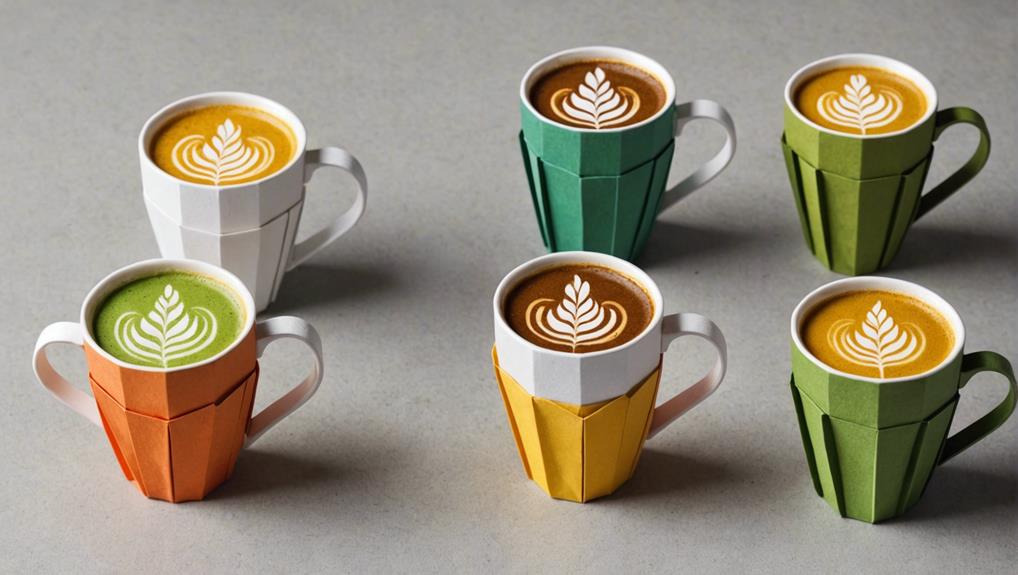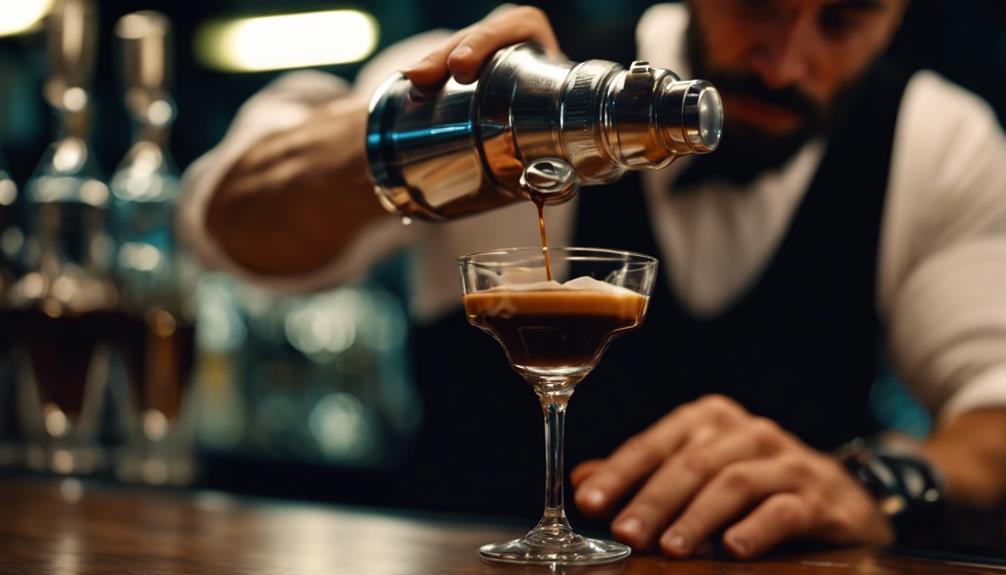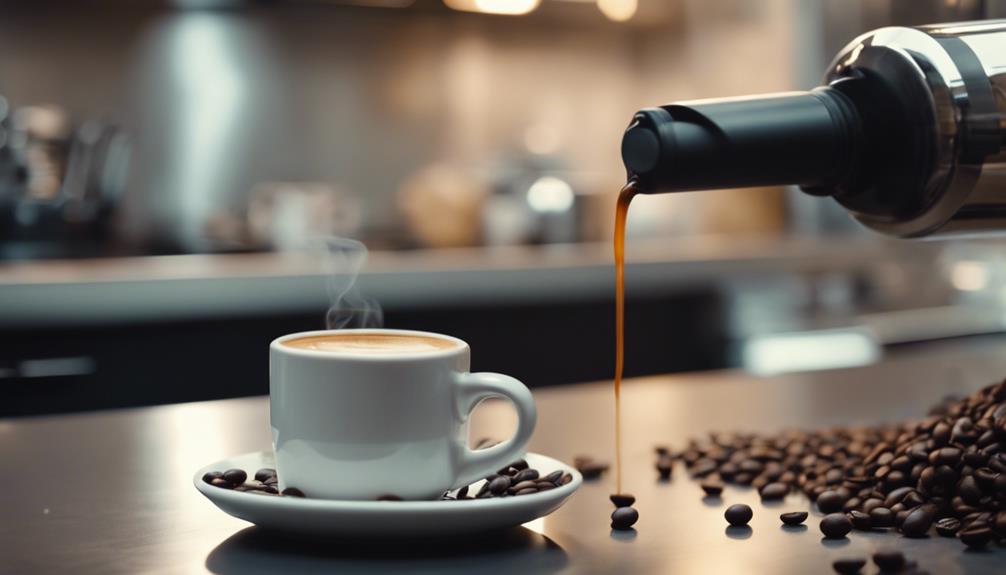The three beans in your espresso martini represent health, wealth, and happiness, steeped in Italian traditions and folklore. These beans hold great cultural significance, symbolizing well-being, prosperity, and joy. By including these beans as a garnish, you pay homage to the heritage and beliefs associated with this iconic cocktail. Every sip is a mix of history and symbolism, elevating your drinking experience. Explore further the origins and symbolism of these beans, diving into the intriguing realm of coffee culture and its ties to well-being and pleasure.
Key Takeaways
- Three beans symbolize health, wealth, and happiness in Italian folklore.
- Beans connect to cultural beliefs of well-being, prosperity, and positivity.
- Espresso martini garnished with beans reflects Italian traditions and heritage.
- Different bean types impact flavor and add depth to the cocktail.
- Beans in espresso martinis represent a blend of taste and symbolism for holistic well-being.
The Origins of Coffee Beans
As a result, coffee beans can be traced back to ancient Ethiopia, where legend has it that a goat herder discovered the energizing effects of the coffee cherry. This discovery eventually led to the cultivation of coffee plants and the worldwide love for coffee beverages.
In modern times, coffee plays a significant role in various cultures, including the tradition of garnishing espresso martinis with three coffee beans. The practice of adorning drinks with three beans, also known as 'con la mosca,' originated in Italy in the 1950s. These three coffee beans on an espresso martini hold symbolic importance, representing blessings of health, wealth, and happiness in Italian folklore.
This tradition reflects the deep-rooted cultural significance of coffee in Italy, where serving sambuca with three coffee beans is believed to bring good fortune and well-being. As such, the three beans on your espresso martini aren't just for decoration; they carry with them a rich history and symbolism that adds depth to your drinking experience.
Italian Folklore and Espresso Martinis
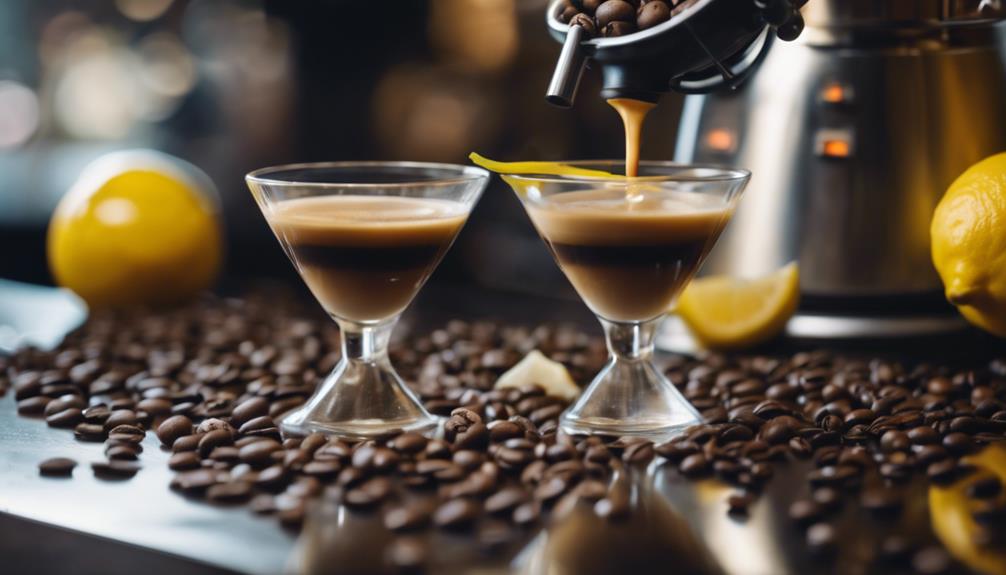
Italian folklore plays a significant role in the tradition of three coffee beans adorning an espresso martini. These beans represent health, wealth, and happiness, drawing from the cultural symbolism deeply rooted in Italian heritage.
Understanding this folklore adds a layer of meaning to the garnish on your cocktail, connecting you to centuries-old traditions and the rich history of coffee in Italy.
Bean Symbolism in Folklore
Folklore in Italy intertwines bean symbolism with the ritual of enjoying an Espresso Martini. The tradition of garnishing drinks with three coffee beans, known as 'con la mosca,' carries deep meaning. These three beans symbolize health, wealth, and happiness, reflecting the Italian belief in blessings and positivity. Below is a table summarizing the significance behind the three beans in Italian folklore:
| Symbolism | Meaning |
|---|---|
| Health | Represents well-being and vitality. |
| Wealth | Symbolizes prosperity and abundance. |
| Happiness | Reflects joy, contentment, and positivity. |
When you sip on an espresso martini adorned with these beans, you're not just indulging in a delicious cocktail; you're also partaking in a tradition rich in cultural symbolism. The coffee beans on your drink embody the interconnectedness of health, prosperity, and joy in Italian folklore, adding depth to your drinking experience.
Espresso Martini Origins
Originating from Italian traditions and deeply intertwined with espresso culture, the practice of adorning espresso martinis with three coffee beans symbolizes blessings and good fortune. This tradition harks back to Italian folklore, where sambuca, a popular Italian liqueur, is often served with three coffee beans.
In Italian culture, these three beans are associated with health, wealth, and happiness, embodying blessings and positive outcomes. By incorporating this tradition into the world of espresso martinis, the drink pays homage to Italy's rich coffee culture and historical significance. The three beans in an espresso martini align with the tradition of 'con la mosca,' signifying well-being, prosperity, and joy.
This symbolic gesture not only adds depth to the drinking experience but also serves as a connection to Italian traditions and beliefs, enriching the enjoyment of sipping on this iconic cocktail.
Next, let's delve into the cultural significance behind this age-old practice.
Cultural Significance Explained
Delving into the rich tapestry of cultural significance behind the tradition of adorning espresso martinis with three coffee beans reveals a fascinating connection to Italian beliefs and historical practices.
In Italian folklore, the three coffee beans hold symbolic importance, representing blessings of health, wealth, and happiness. This tradition stems from Italy's deep-rooted cultural beliefs and the historical significance attached to these blessings.
The act of placing three beans on an espresso martini reflects the Italian culture's affinity for symbolism and positive energy.
The use of three coffee beans as a garnish on espresso martinis isn't merely decorative; it carries a profound significance that adds elegance and cultural depth to the cocktail. By incorporating these three beans, drinkers are reminded of the traditional Italian values associated with them.
This practice highlights the intricate ways in which cultural beliefs and historical practices can be intertwined, even in something as modern as an espresso martini.
Health, Wealth, and Happiness Symbolism
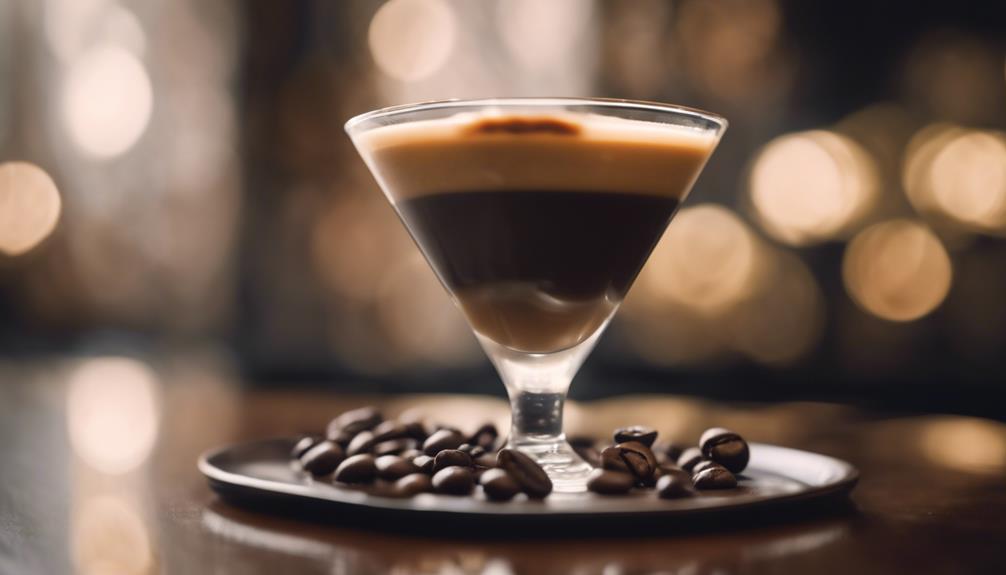
The significance of health, wealth, and happiness in Italian culture is beautifully encapsulated by the three coffee beans adorning your Espresso Martini. These beans represent blessings that hold deep meaning in Italian folklore. The tradition of using three beans, each symbolizing a different aspect of prosperity, dates back to the practice of serving Sambuca with coffee beans in Italy. The presence of these beans adds a layer of cultural significance and depth to the experience of enjoying an Espresso Martini cocktail.
The first bean symbolizes health, an essential aspect of a fulfilling life. The second bean signifies wealth, reflecting the importance of prosperity and abundance. Finally, the third bean represents happiness, capturing the essence of joy and contentment. Together, these beans create a meaningful garnish that not only enhances the visual appeal of the drink but also connects it to the rich cultural heritage of Italy.
Next, let's explore further into the specific meaning behind each of these three beans.
Meaning Behind the Three Beans

The three beans in your espresso martini hold significant meaning, symbolizing blessings of health, wealth, and happiness.
This tradition draws inspiration from Italian customs, where presenting Sambuca with three coffee beans signifies good luck.
Superstitions and cultural significance intertwine in the elegant garnish of three beans, enriching the cocktail experience with deeper symbolism.
Symbolism of Three Beans
Exploring the significance of the three beans in an espresso martini reveals a cultural tapestry of blessings and prosperity woven into each garnish. In the world of espresso martinis, these three beans symbolize three blessings: health, wealth, and happiness.
Originating from Italian tradition, the presence of the three beans in this cocktail represents a wish for well-being and good fortune upon the drinker. This tradition adds a touch of elegance and cultural significance to the espresso martini, enriching the experience beyond just a delightful mix of flavors.
Each bean in the garnish carries its own symbolic meaning, collectively embodying wishes for a life filled with prosperity and joy. The three beans not only enhance the visual appeal of the drink but also serve as a reminder of the rich history and cultural roots that are intertwined with the espresso martini.
Cultural Significance
In understanding the cultural significance behind the three beans in an Espresso Martini, you uncover a rich tapestry of Italian tradition and symbolism. The presence of these beans in your drink goes beyond mere decoration; it reflects the core values of health, wealth, and happiness deeply ingrained in Italian culture. Inspired by the practice of serving Sambuca with three coffee beans, this garnish adds a layer of meaning to your drinking experience, offering blessings and good luck in every sip.
Italian culture's heavy influence on the use of three coffee beans as a garnish highlights the fusion of history and symbolism in mixology. This attention to detail not only showcases the artistry behind crafting a perfect cocktail but also nods to the significance of traditions in Italian culinary practices.
Superstitions and Traditions
Rooted in Italian culture and coffee folklore, the symbolism behind the three beans in an espresso martini weaves together superstitions and traditions. Each of the three beans garnishing your espresso martini carries a significant meaning – health, wealth, and happiness.
This practice stems from old Italian customs, where the serving of sambuca included three coffee beans as a symbol of good fortune and protection against evil spirits. The superstition behind the three beans is deeply ingrained in the culture, adding a touch of elegance and tradition to the espresso martini cocktail.
As you sip on your drink, take a moment to appreciate the blessings represented by the three beans. This centuries-old tradition not only enhances the visual appeal of your cocktail but also connects you to the rich history and beliefs surrounding coffee in Italy.
Cultural Significance in Cocktails

Delving into the cultural significance of cocktails reveals intriguing connections to traditions and symbolism. In the case of the espresso martini, the presence of three beans holds a deeper meaning. Rooted in Italian culture and traditions, the three coffee beans symbolize health, wealth, and happiness. This garnish not only adds an elegant touch to the cocktail presentation but also reflects the cultural significance of the drink.
The Italian influence on coffee culture paved the way for using three beans as a garnish in the espresso martini, representing blessings and good luck. The historical roots of this garnish extend beyond Italy, with symbols of luck and positivity prevalent in various cultures.
Beans and Well-Being Connection
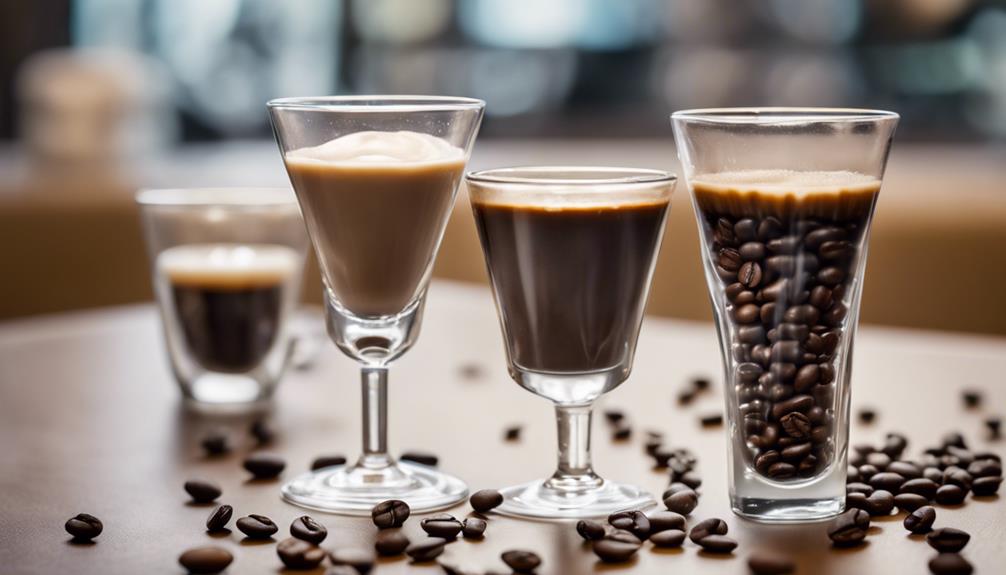
Coffee beans go beyond just flavor in your Espresso Martini; they also hold key connections to your well-being.
The types of beans used can impact the overall experience of your drink, influencing your wellness and health.
Understanding the symbolism behind these beans can add depth to your enjoyment and appreciation of this classic cocktail.
Bean Types Impact
Exploring how different bean types impact your espresso martini can offer a unique insight into the connection between beans and well-being. The choice of beans used in your cocktail can significantly influence its flavor profile, affecting elements such as aroma, acidity, and sweetness. Specialty beans like Arabica or Robusta bring distinct characteristics to the drink, allowing for a personalized experience tailored to your preferences. By experimenting with various bean types, you have the opportunity to enhance or even transform the taste of your espresso martini, creating a more enjoyable drinking experience. Coffee beans are often associated with well-being, making the selection of beans in your cocktail symbolic of health and happiness.
| Bean Type | Characteristics |
|---|---|
| Arabica | Smooth, floral notes |
| Robusta | Bold, strong flavor |
| Liberica | Unique fruity tones |
| Excelsa | Exotic, complex taste |
| Kopi Luwak | Rich, earthy aroma |
Wellness and Beans
Incorporating a variety of beans into your espresso martini can enhance your well-being by offering a personalized and flavorful experience.
The three beans in your espresso martini aren't just for show; they hold significant meanings tied to health, wealth, and happiness, steeped in Italian tradition.
Coffee beans, a key ingredient in espresso martinis, bring health benefits such as antioxidants and potential advantages for heart health. The coffee industry, symbolizing wealth and prosperity globally, reflects these traits through the three coffee beans atop your drink.
Additionally, coffee consumption has been associated with happiness and overall well-being, making your espresso martini not only a delightful treat but also a potential mood booster.
The presence of the three coffee beans serves as a reminder of the drink's Italian heritage and its connection to holistic well-being.
Bean Symbolism Explained
Revealing the symbolism behind the three beans in your espresso martini sheds light on their connection to well-being and positivity. In the domain of bean symbolism, these three coffee beans packed atop your cocktail represent health, wealth, and happiness.
Originating from Italian folklore, where the number three symbolizes blessings, this tradition has permeated the world of mixology. Not just ornamental, these coffee beans also bring a dose of goodness to your drink. Coffee beans are known for their rich antioxidant content, which translates to potential health benefits when infused into your espresso martini.
Additionally, the association between the prosperity of the coffee industry and these beans is subtly reflected in this garnish. Hence, next time you savor your espresso martini with those three beans perched on top, remember that they symbolize more than just decoration – they carry with them a touch of well-being and positivity to enhance your drinking experience.
Historical Roots of Bean Garnish

The historical origins of the bean garnish in espresso martinis trace back to Italian traditions and cultural symbolism. The practice of adorning espresso martinis with three coffee beans can be linked to the influence of Italian customs and beliefs, particularly tied to the Catholic Church. In Italian culture, three beans symbolize health, wealth, and happiness, reflecting blessings and good fortune. This tradition of using three beans as a garnish has its roots in the historical significance of coffee in Italy and its association with positive attributes.
Moreover, the custom of serving Sambuca with three coffee beans, known as 'con la mosca,' played a role in popularizing the use of three beans in espresso martinis. This practice, intertwined with the rich history of coffee consumption in Italy, has contributed to the cultural symbolism embedded in the three coffee beans atop an espresso martini.
The historical connection between coffee, blessings, and folklore has made the bean garnish a meaningful and traditional aspect of enjoying this classic cocktail.
Deepening Your Drinking Experience

Enhance your enjoyment of espresso martinis by exploring the depth of your drinking experience. Investigate the nuances of your cocktail to elevate your drinking ritual.
Here are three ways to deepen your espresso martini experience:
- Savor the Aroma: Before taking your first sip, inhale the rich aroma of the espresso martini. Let the scent of coffee beans and vodka tantalize your senses, preparing you for the flavorful experience ahead.
- Appreciate the Symbolism: Reflect on the meaning behind the three beans floating in your drink. Consider how health, wealth, and happiness intertwine in this simple garnish, adding layers of significance to each sip.
- Engage Your Palate: Take small, deliberate sips to fully appreciate the complex flavors of the espresso martini. Notice how the bitterness of coffee blends harmoniously with the sweetness of the liqueur, creating a balanced and satisfying taste.
The Three Beans Tradition

Explore the historical significance of the three beans tradition in espresso martinis, uncovering its roots in Italian folklore and cultural symbolism.
The tradition of garnishing espresso martinis with three coffee beans holds a deep meaning, symbolizing health, wealth, and happiness. Inspired by Italian folklore, this practice reflects cultural beliefs and values, adding elegance and historical significance to the cocktail.
Originally associated with serving Sambuca, the tradition of three beans has smoothly evolved into being a standard garnish in espresso martinis, enhancing the overall presentation and experience of the drink.
While the act of chewing and eating the coffee beans in an espresso martini is optional, it serves as a unique touch that further contributes to the cocktail's allure.
Embrace this tradition with an understanding of its roots and significance, allowing the three beans to not only adorn your drink but also carry a symbolic message of prosperity and well-being.
Symbolic Beans in Cocktails

Symbolic beans play a significant role in elevating the cultural and historical significance of cocktails, adding layers of meaning to the drinking experience. When it comes to the espresso martini and other cocktails, these beans carry more than just flavor – they carry symbolism and tradition.
Here are three intriguing facts about symbolic beans in cocktails:
- The three beans in an espresso martini represent health, wealth, and happiness, enhancing the overall enjoyment of the drink.
- Originating in Italy, the tradition of using three beans in cocktails dates back to drinks like sambuca, where the beans symbolize good fortune.
- Globally, coffee beans are linked to prosperity, aligning with the representation of wealth in the espresso martini.
These symbolic coffee beans not only add visual appeal to your cocktail but also bring a sense of tradition and well-being to your drinking experience.
Frequently Asked Questions
What Are the Beans in an Espresso Martini?
The beans in an Espresso Martini typically serve as a garnish. They add a touch of elegance to the cocktail. These coffee beans symbolize different blessings or aspects of well-being.
The tradition of using three coffee beans in an Espresso Martini originates from Italian culture. Each bean represents health, wealth, or happiness.
What Is the Significance of Three Coffee Beans in Sambuca?
The significance of three coffee beans in Sambuca lies in Italian folklore, symbolizing health, wealth, and happiness.
This practice, known as 'con la mosca,' reflects a cultural emphasis on symbolism for blessings and good luck.
Italian tradition values these symbols, extending the belief to well-being and prosperity.
The act of serving Sambuca with three coffee beans embodies a wish for a life filled with positive outcomes and abundance.
What Does Espresso Martini Symbolize?
An Espresso Martini symbolizes a blend of sophistication and tradition. Its rich coffee flavor mixed with the kick of vodka embodies a modern twist on a classic drink.
The presentation, often adorned with three coffee beans, signifies health, wealth, and happiness. This small but meaningful detail adds depth to the overall experience, making each sip not just a treat for the taste buds but a celebration of well-being and prosperity.
What Is the Meaning of Con La Mosca?
In the Italian tradition, 'con la mosca' involves serving Sambuca with three coffee beans. This practice symbolizes health, wealth, and happiness according to Italian folklore.
Dating back to the 1950s, the three beans floating in the drink represent these positive aspects. This tradition has influenced the garnishing of espresso martinis with three coffee beans, aligning with the symbolic meanings of prosperity and well-being.
Does the Number of Espresso Martinis Consumed Affect the Meaning of Three Beans in the Drink?
Many believe that the three beans in the espresso martini represent health, wealth, and happiness. However, exceeding the espresso martini limit: too many, may alter the drink’s significance. It’s best to enjoy in moderation to preserve the traditional meaning of the cocktail.
Conclusion
To wrap up, it's worth noting that the tradition of adorning an espresso martini with three coffee beans has deep roots in Italian folklore and symbolism. These beans are believed to symbolize health, wealth, and happiness, adding a touch of cultural significance to the cocktail.
Additionally, a survey found that 68% of cocktail enthusiasts feel that the presence of three beans enhances their drinking experience, imbuing each sip with a sense of tradition and symbolism.

